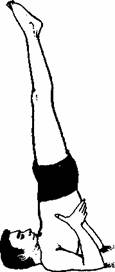| Yoga : Sarvangasana |
 Shoulderstand Posture: Sarvangasana Sarva means 'all' or 'complete', and anga means 'body': hence the Shoulderstand is sometimes called in English the All-body or the Complete Posture. Another English title, because the legs and trunk are held straight up, is the Candle Posture. Lie flat on the back, the legs extended together. Bend the legs and bring back the knees to above the chest. Use the elbows and upper arms as a base (elbows not wider apart than shoulders' width) and prop the body by placing the hands against the small of the back with the thumbs spread apart from the fingers. Note that the hands could not be placed against the hips as in the Half Shoulderstand Posture, because the hips are now to be raised much higher. Bring the trunk to a vertical position and extend the legs straight up so that the legs and trunk form a straight line perpendicular to the floor. In bringing the trunk upright the sternum touches the chin. Bring the chest to the chin, not the chin to the chest. Bodyweight is centred on the shoulders and neck. Breathe freely and deeply in the abdomen. Stay steadily in the candle-like position for at least twenty seconds. Come out of the pose slowly and smoothly. The Shoulderstand or All-body Posture is not mentioned in the traditional literature, but its history is a long one. It is a boon to those who cannot master the Headstand, or who find the latter too hazardous. Even those who are skilled in the Headstand should never omit the Shoulderstand from regular practice. Sarvangasana, by inverting the body, enables the venous blood to flow to the heart without battling with gravity. Blood flows to the brain, and to the scalp and facial tissues. The Shoulderstand has the reputation of being a rejuvenator. Blood also flows to the neck, with a beneficial effect over the thyroid and parathyroid glands. The nervous system is calmed. The spine is strengthened, and the whole body firmed and toned. Sarvangasana relieves congestion in the lees pelvis, and abdomen, and prevents or relieves varicose veins, asthma, insomnia, constipation, prolapsus, menstrual disorders, and menopause disturbances. It is said to increase sexual fitness in both men and women. It stimulates the endocrine glands, and invigorates the whole body in a harmonious way. The Shoulderstand is unsuitable in cases of high blood pressure, spinal weakness, any disorder of the thyroid gland, chronic sinusitis or nasal catarrh, angina, otitis, sclerosis of the blood vessels of the brain - in short, severe ailments of the neck and head. Any reader with doubts about the suitability of the pose should take the advice of his doctor.
Learning the Headstand The Headstand, in the fully inverted form, is a more severe posture than the Shoulderstand. Either the forearms, elbows, and sides of the hands, or alternatively the palms of the hands, provide an aid to steady balance - most Yoga instructors advise the former. Either way, much of the weight of the body is taken by the top of the skull. It is advisable, therefore, to exercise on a folded blanket or rug, a thick carpet, or some other soft surface which will cushion a roll over. In addition, a cushion or pad may be required to protect the head - this should be stable and of uniform thickness. Like the person who takes up Judo, the person who wishes to master the Headstand Posture should first learn how to roll over without fear or discomfort. There should be a soft and even surface on which to land, and room to tumble over without the risk of painful knocks against furniture or other objects. Take up the Sirsasana. The hands cup the back of the head, with the fingers interlaced and interlocked. The inner edges of the hands rest on the floor, as do the forearms and elbows, the latter spread not wider than the shoulders. The top of the head rests on the floor. The trunk is vertical, and the legs are straight, with the toes resting on the floor. (The hand and arm position just described is that favoured by most Yogins in the headstand: the alternative is to place the palms of the hands flat on the floor at shoulders' width, the fingers pointing forward and spread. In both methods the arms are used to aid balance.) A sway forward or to one side will be detected by the clasped hands or the forearms respectively in the position we are here describing. Bring the knees forward towards the chest, hunching up the body into a relaxed ball. Then roll over, the way children delight in rolling on grass. As you roll over, always observe three rules: i Roll up into a relaxed ball. Have you noticed how young children and drunken men seem to be protected against falls? This is because they usually fall while relaxed. So make this rolling over practice child's play - or tipsy man's play if you prefer, ii. Unclasp the hands immediately you start to go over; otherwise the locked hands could receive a painful jerk. iii. Bend the legs so that the soles of the feet slap the floor and act as shock-absorbers. Practise the roll over until it presents no problems. The principles just described apply equally to an overbalance from the full Head-stand, which should be rare if one learns in stages as described here. The learning stages in themselves are valuable exercises, bestowing many of the physiological benefits claimed for the full Headstand Posture. The body should be conditioned by the Quarter Head-stand; then by the Half Headstand; and finally by the Assisted Headstand. The Shoulderstand also provides preparation for the full Headstand, for it accustoms the body to the inverted posture. |
|
|